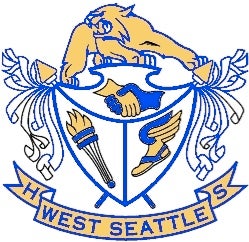French
West Seattle HS French Courses
Welcome! Here you can find information about the French teachers at WSHS, the levels offered, and our pedagogy.
There are two French teachers at West Seattle High School. We alternate the levels that we teach from year-to-year, so it is subject to change.
Meghan Schumacher
Meghan Schumacher is originally from Denver, Colorado. She learned French in college at Colorado State University and received the Outstanding French Scholar Award upon graduating. She lived in France as an au pair and has also lived in Ecuador.
She received a Master’s in Education from Boston College where she studied second language acquisition and English Language Learning.
Mme Schu’s philosophy of teaching is that ALL students can become proficient in a language, and she designs her program around success and fluency for all. She is an AIM certified teacher and uses the AIM method in levels 1 and 2. She is also National Board Certified. She has been teaching for 20+ years.
Contact Meghan Schumacher at mkschumacher@seattleschools.org
Bethany Lidgard
Bethany Lidgard is a West Seattle Native! She started learning French in high school and then fell in love with it following three weeks of hosting a French student through the ORCA exchange program.
After double majoring in French and Romance Linguistics at the University of Washington, Bethany completed her Masters in Teaching at UW, then taught for five years at Garfield High School, where she grew the French department, was on the Racial Equity Team, worked on the Data Team, coached volleyball, and was a World Language Department Co-Chair for three years.
Mme Lidgard believes strongly that EVERY student can learn a language, and loves using Comprehensible Input methodologies in class. She also enjoys working Ethnic Studies into her curriculum, she is constantly growing her awareness as a white woman, and she believes that all students can benefit from learning from diverse viewpoints.
Contact Bethany Lidgard at belidgard@seattleschools.org
We offer five levels of French:
- Level One (Introduction, Basics)
- Level Two
- Level Three
- Level 4
- Level 5/AP
Note: Levels 4 and 5 are often taught in a combined class, with a rotating AP Curriculum
Choosing a Level
French One or Two?
If you took French in middle school, you might be wondering if you’re ready to sign up for French 1 or French 2. The answer is pretty simple—all you have to do is think of your answer to these two questions:
- How well did you do in Middle School French? If you got at least a B, then move on to question 2. If not, you should definitely go for French 1 and we’ll get it done!
- Are you intimidated or excited by an immersion environment? If you are excited about speaking and using only French in class and are okay with it feeling a little intimidating at first, then go for it! If it terrifies you, then starting at level 1 means starting with the most basic words for communication and this will give you the foundation to use only French that you will need to be successful throughout the program.
French 4 or AP?
At the end of French 3, you can choose to go directly to AP or spend a little more time building your proficiency first. French 4 and AP students are in the same room and get a rotating curriculum, so you’ll be introduced to the same 6 AP themes but do different activities over the course of the two years in the French 4/AP class.
Students in AP French get a GPA bump for the rigorous curriculum and assessments. Students in French 4, on the other hand, will take the same assessments as the students in the AP class, but will be graded more easily. All students will have the option of taking the AP French exam whether they are in French 4 or AP.
We operate using the over-arching Comprehensible Input Methodology. This means that we try to help students learn language the natural way, through immersion and using input that’s just above student proficiency. In levels one and two, we use the AIM curriculum.
French One and Two
Welcome to French 1 and 2! It is here that we build a very strong foundation of communication. We do this primarily by using the language in the classroom in fun and engaging ways. You’ll be acquiring the language without even really thinking about it because you’ll be busy doing fun and engaging activities!
What do we do in class?
In class, we use a method called AIM, which stands for Accelerated Integrated Method. It’s accelerated, which means you learn REALLY fast, and it integrates many different activities which address learning styles in many different ways including for visual, auditory, and kinesthetic learners. This is done by incorporating gesture-based learning with songs, raps, stories and plays, games, and puppets, and by working as a whole class, in small groups, and with partners. It is an immersion classroom, which means that everyone is speaking only in French, even in French 1! But don’t worry–there is plenty of help so that you know how to say what you want to say.
What can I expect for homework?
In French 1 and 2, we have homework on Monday nights. It takes 5-10 minutes to complete and is designed to practice vocabulary or grammar (level 2). Vocabulary practice takes place on Quizlet.
How will I be graded?
This class uses standards-based grading. The standards for world languages are Communication (interpretive listening and reading, interpersonal speaking and writing, presentational speaking and writing), Cultures, Comparisons, Connections and Communities. Grades are weighted so that Communication is worth 70% of the grade and the four other standards make up the remaining 30%. Practice is limited to 5% of the grade. The goal for French 1 is meeting standard at the Novice Mid level, and for French 2 the level is Novice High.
French Three, Four, and AP
Welcome to advanced French! By the time you get to French 3, you are likely relatively comfortable communicating in the language and now you’re ready to make your language more complex and precise.
What do we do in class?
In French 3, 4 and AP we follow the 6 AP French themes. We spend 4-6 weeks on each theme, exploring different topics at different levels. We read articles, watch short video clips, work as a class, in small groups, and partners, and explore the world through language. We also examine French and Francophone culture around the world by exploring cultural values and traditions in various French-speaking regions.
What can I expect for homework?
In French 3, 4/AP, we have homework on Monday, Tuesday and Wednesday nights. It takes 10-15 minutes to complete. On Monday, the homework is to annotate (take notes on) the article or infographic for that week. On Tuesday, there is some kind of grammar practice. On Wednesday, students write five descriptive sentences with the vocab words from that week. We have vocab quizzes on Fridays and two tests/a semester. There is a final art project and presentation at the end of semester 1, and a presentation about a Francophone country that you’ve been studying at the end of semester 2.
How will I be graded?
This class uses standards-based grading. The standards for world languages are Communication (interpretive listening and reading, interpersonal speaking and writing, presentational speaking and writing), Cultures, Comparisons, Connections and Communities. Grades are weighted so that Communication is worth 70% of the grade and the four other standards make up the remaining 30%. Practice is limited to 5% of the grade. The goal for French 3 is meeting standard at the Intermediate Low level, for French 4 the level is Intermediate Mid, and for AP French the level is Intermediate High.
In our French classes, we explore culture of the francophone world in a multitude of ways, hoping to find something that sparks inspiration and interest for our students.
What is “la francophonie”?
La Francophonie refers to all of the countries across the world that speak French. There is an official organization called “l’Organisation Internationale de la Francophonie (OIF)”, but it does not include all French-speaking countries. Including countries that are officially identified as a part of OIF and countries where French is spoken, but they are not in the official group, there are 52 countries in la Francophonie. This includes countries such as Canada, Senegal, Morocco, Benin, Vietnam, Lebanon, Burkina Faso, Switzerland, Belgium, and Tunisia, among many others.
Why is this important to us?
We believe that an important part of a French education is learning about not only France, but also about la Francophonie in its entirety. Throughout our courses, we work to include music, history, inventions, important people, overall culture, food, and literature from a diverse array of countries. We do cover French culture, but we study much more than just France, since learning French truly opens the door to so many other cultures, and those cultures need to be respected, seen, and cherished in a French curriculum. This also gives students a chance to see the diversity in the cultures present in the classroom, and to celebrate the diversity within speakers of a language.
Food
This can be a fantastic way to engage with culture!
We have special food days for each level during the first part of November. In French 1, we make crêpes in class. In French 2, we prepare a Haïtian feast. In French 3, we have fondu and in French 4 we have food from Francophone Africa (students choose and plan this meal).
In December, we celebrate French class with a Jour de fête where students make and serve a 5-course French dinner. Students prepare and serve appetizers, soups, main dishes, salads and desserts. Families are invited to join for this special day!
In the spring, we have one more food experience which varies depending on what we are studying. We have been known to have a chocolate tasting, make authentic Belgian waffles, and experience Raclette.
Music
We consistently integrate music into our weekly routines! Some popular artists include:
- Stromae
- Yelle
- Soprano
- Black M
- Maitre Gims
- Vianney
- Bigflo et Oli
- Edith Piaf
- Coeur de Pirate
- Sianna
- Jacques Dutronc
- Louane
- Videoclub
- Zaz
- Angèle
- Roméo Elvis
- Odelaf
- OrelSan
- La Femme
- Raphaél Butler
- Bleu Jean Bleu
- Mika
- Carla
- Sidoine
- Dadju
- Nino Ferrer
- Magic System
Films and Shows
We like to work films into our curriculum when possible. Some films or shows that we might show to our students include:
- Les Choristes
- Versailles: La Visite
- Au Revoir les Enfants
- Joyeux Noel
- Les Grandes, Grandes Vacances
- La Vie en Rose
- Le Petit Prince
- Jean de Florette/Manon des Sources
- Panique au Village
- Bienvenue a Marly Gomont
French Camp
An opportunity to practice French
Some years, our advanced students travel to French Camp, an immersive experience that takes place at another school or camp with ten or more other schools. Students spend the day participating in activities, eating food from French-speaking countries, playing games, singing songs, doing skits, and we finish with a Mardi Gras dance party and prizes. Students make the equivalent of 3 weeks’ worth of progress through this one-day immersion experience and have fun and make new friends in the process!
CIEE Global Navigator Program for Summer Study Abroad
All students in all languages and students not taking a language are eligible to apply to study abroad through the Council for International Educational Exchange through their Global Navigator Program. Programs are offered in over 20 countries and include Language and Culture programs, Service and Leadership programs, and Global Discovery programs which include programs in theater, arts, and environmental studies, to name a few. Students who apply to Language and Culture programs are eligible for a generous scholarship from a donor in California. Our students have earned $100,000 in scholarships since we started our partnership with CIEE in 2017.
Learn more about the Global Navigator Program
Passepartout Program/Sister Schools Program
Nantes is one of Seattle’s sister cities and we also have a partnership between our schools. West Seattle High School is one of the only high schools in the state of Washington to have a sister school in France. Our sister school is called lycée François Rabelais and it is located in the town of Fontenay-le-Comte, which is about one hour south of Nantes.
What do we do with our sister school?
We began our partnership in the spring of 2021 by getting penpals from our sister school and corresponding electronically. Future activities might include exchanging cultural projects and even doing a student exchange!
- Website for our sister school
- Website for the town
- Article on 10 reasons why you should visit Nantes at least once
- Seattle-Nantes Sister Cities Association. Anyone can join!
Orca Exchange Program
The ORCA program is through a non-profit that organizes exchanges with French students. Students from France apply to the program, and then Madame Morrison (our Seattle-area coordinator) visits Seattle area high schools to find American students interested in hosting the French students. Interested families have a home visit with Mme Morrison and pick the student they think would be a good fit for them. The exchange visits are usually in July, and last for three weeks. ORCA coordinates activities for students and their families to enjoy throughout the three weeks, so you don’t need to worry about entertaining a student the entire time. However, you do have the option to not participate in these group outings. ORCA does not guarantee an exchange, but if you get on well, you might strike up a friendship and exchange naturally. This program can lead to life-long friendships and bonds.
The Possibilities Are Endless!
Scroll through below to discover many ways, with technology and without, that you and your students can keep practicing French long after class has ended. These are just a few of our favorites.
Label Things Around the House!
One idea to maintain French where you won’t need internet is to label your possessions! Then, when you see the label, you say the word out loud, or, for more challenge, use the word in a complete sentence. If you really want to challenge yourself, you could make the item into a character and make a story for it! Or, if you are feeling less creative, you could describe the item, what it looks like, and what you use it for.
Some words to get you started:
- Le livre: the book
- La fenêtre: the window
- Le couloir: the hallway
- La chambre à coucher: the bedroom
- Le salon: the living room
- La salle à manger: the dining room
- La table: the table
- La cuisine: the kitchen
- Le four: the oven
- Le placard: the cupboard or the closet
- La poubelle: the garbage can
- Le recyclage: the recycling
- Le composteur: the compost bin (usually referring to a large one outside for individual house composting: large-scale city composting is still rare in France)
- Le canapé: the couch
- Le frigo: the fridge
- Le four à micro-ondes: the microwave
- Le portable: the phone
- L’ordinateur: the computer
- La porte: the door
- Le mur: the wall
- Le sol: the floor
- Le plafond: the ceiling
- L’évier: the sink
- La chaise: the chair
- L’interrupteur: the light switch
- La commode: the dresser
- Le bureau: the office or the desk
- Les haut-parleurs: the speakers
- La plante: the plant
- Le jardin: the garden
- La théière: the teapot
- La cafetière: the coffeemaker
- Le lave-vaisselle: the dishwasher
- La télévision: the TV
Journaling
At the end of each day, write a little bit about what you did that day. This is a great opportunity to practice words that you already know and to look up new words on wordreference.com. It’s also a great time to practice your two past tenses, imparfait and passé composé! While editing your work, focus on verb conjugation, using adjectives to describe things, and adjective placement and agreement.
I would recommend trying to write about five sentences a day (or more) and work on writing more each time you journal. You could also try writing a story or a children’s book in French! Writing is great practice.
You can then use what you’ve written to work on speaking, by reading the journal out loud to yourself. When doing the reading, focus on not pronouncing word final “s” or “ent”, on pronouncing accented letters correctly, and on using nasal sounds for vowels followed by an “n” or “m”.
Listening Practice
There are many websites for this
Coffee Break French: Pick your level for some fun listening
Le Français Naturellement: Stories for French Learning (might be too easy for higher levels)
Watching Your Favorite Shows: Netflix and other streaming services often offer shows and movies in French! I highly recommend watching shows you have seen before in French with French subtitles so that you know what’s going on and you can focus in on the language. PLEASE put your subtitles in FRENCH and not in English. Complete immersion is more helpful to acquisition, especially when you know the context already.
French Radio: Challenging Listening
Listening & Reading Practice
More great websites for practice!
- TV 5 Monde (listening and reading activities)
- 1 Jour 1 Actu: Written News and Videos in Easier French
- Stories in French (reading with videos!)
- French In Action (video series Mme Schu used to learn French in college)
- Radio France Internationale
- Les Haut-Parleurs—news for youth
Reading Practice
A natural option is to buy a French book, or borrow a French reader from your teacher. If that’s not an option, here are a couple:
Fables and Fairy Tales in French↗
Grammar Practice
Especially once you have an organic handle on the language, you may want a little formal grammar practice to fine-tune your skills:
- Grammar Practice and Some Writing Tips
- Grammar and Some Reading from Univ of Texas
- French Practice Activities by topic on Le Point du FLE
- Kwiziq—uses AI to give you personalized grammar practice
Miscellaneous
A place to practice dictations:
Our recommended YouTube Channels:





